
views
X
Research source
A properly constructed igloo can have an inner temperature ranging from −7 °C (19 °F) to 16 °C (61 °F), even if the temperature outside dips to −45 °C (−49 °F)![2]
X
Research source
Building an igloo is relatively simple, and can be done over the course of a few hours. All you need is the right kind of snow and some know-how, and your igloo will be sure to impress.
Plotting out Your Igloo
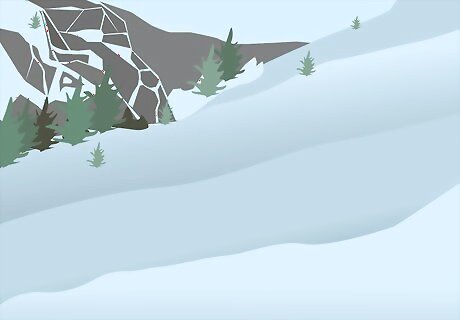
Build on a slope to save effort. Of course, an igloo can be built on flat land without any problems, but by building your igloo into a hillside, the slope will cut down on the surface area of your igloo dome. Less surface area means fewer bricks, and fewer bricks mean less work for you. In survival situations, a hillside building site should be prioritized. Avoid free-standing mounds, as these are likely logs or boulders buried in snow. Use a snow prod or a long stick to verify usable space for your igloo.
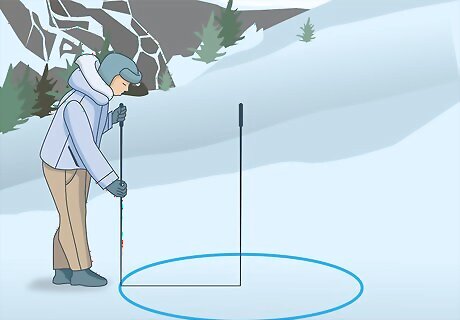
Use a snow prod to test the snow for consistency. Ideally, you'll want to cut the bricks of your igloo from snow that is hard packed with no soft layers of soft snow in it. Use your snow prod or a long stick to check the snow, which should offer firm, uniform resistance if hard packed throughout. Measure the depth of your snow while checking consistency. You'll want the snow to be at least 2 feet (0.61 m) deep to make your igloo.

Outline the outer wall of your igloo. Use the heel of your boot to scuff out a line marking the circular outside of your igloo. The snow on the inside of your circle should all be consistently hard packed, and your circle should be regular in shape. A poorly outlined outer wall will result in your igloo's design being less stable and sturdy. Never build a dome with a diameter larger than 10 feet (3.0 m), as it will require you to build a perfect dome. This is a nearly impossible task, even with special tools.
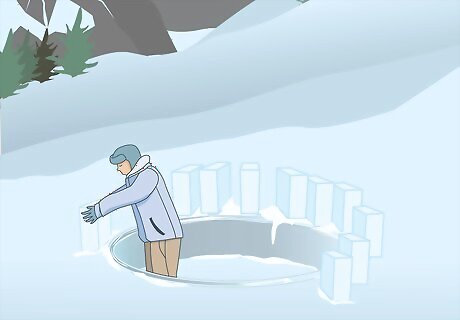
Know your general plan for igloo construction. You'll soon be using snow blocks cut from the snow inside the outer perimeter of your igloo to build the walls of your igloo dome. You'll be building from the inside out, cutting the door of your structure after finishing your dome from the inside.
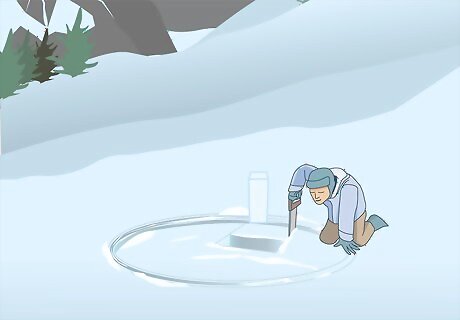
Cut a narrow rectangular trench to prepare to harvest blocks. Depending on the size of your igloo, the size of your blocks can change, but traditionally igloo blocks are 3 feet (0.91 m) long, 15 inches (38 cm) high, and about 8 inches (20 cm) thick. Cut a narrow rectangular trench with your snow knife to accommodate several blocks this size. Cut your trench in a way that places one of its short ends flat against the outer perimeter line of your igloo. The place your trench and outer wall boundaries meet will eventually become your outside door. If working on a slope or building your igloo into a hillside, dig your trench directly toward the slope. A handsaw or machete can be used in place of a snow knife.
Making Your Igloo Dome
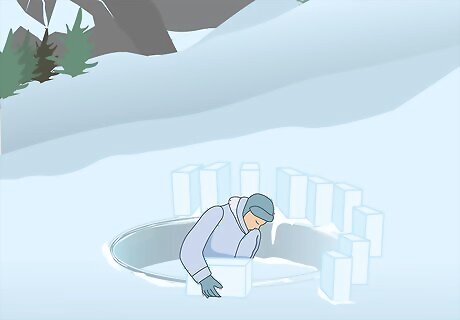
Harvest your blocks and begin assembling your first row. Section the hard packed snow inside the perimeter of your rectangular trench into equal rectangular blocks. Stubborn blocks can be broken free by sticking your snow tool into the cut around the block and gently wiggling it back and forth until the block is broken free. Then arrange your blocks around the perimeter of your igloo to create the first layer of your dome. Your blocks should be 3 feet (0.91 m) long, 15 inches (38 cm) high, and about 8 inches (20 cm) thick, and should taper slightly as you build upward. Run your snow knife, machete, or handsaw along the edges of your first row of blocks where one block joins the next. This will smooth contours and help fit each block together tightly. When your rectangular trench no longer has snow for blocks, cut another trench the same dimensions as the first. All the snow used in building your dome should come from within the perimeter of the igloo.

Cut a slope into your first row of snow blocks. Due to the rectangular shape of your blocks, you will need to cut a gentle slope inclining from the ground all the way to the top height of your first row of snow blocks. This incline should extend part way around your igloo (perhaps even as much as halfway), and should be cut with your snow knife, machete, or handsaw. This incline will allow your blocks to be stacked in a vertical spiral, creating a snug fit.

Level and shape igloo walls when necessary. This will make stacking and layering the ice blocks much easier. Additionally, as you build your dome upward, you will need to shape your snow blocks to fit the reduced space at the top of your dome. Use your snow knife, machete, or handsaw to do this as necessary. Each row of your igloo dome should slope gradually inward. Use your snow knife, machete, or saw to create a very gentle inward slope for each row of snow blocks. Using your hand, plug any gaps you find in your dome from the inside with snow. Simply pat snow into the gap until it is filled.
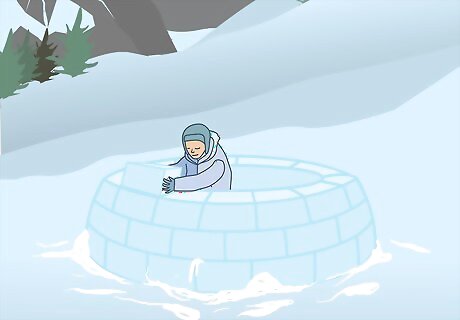
Add blocks cut from the snow inside the igloo perimeter. Continue to liberate blocks from the snow within your igloo perimeter with your snow knife/machete, and then stack your next layer starting from the sloping end of your first row. As your dome wall rises, blocks will begin to decrease in size and slope inward. To increase stability and prevent ceiling blocks from falling, bevel the edges where ceiling blocks meet the row beneath. To bevel, cut the inside corner of your ceiling block so that it forms a flat base with its neighboring block beneath.

Fit your cap-hole blocks carefully. The topmost blocks in your igloo dome are notoriously tricky to fit into place, so take your time and work carefully during this leg of your igloo building. Use your snow knife/machete to sculpt these pieces to fit tightly together. Since your final hole will be exceptionally small, you will have to turn your final block on its end and feed it through the hole on its side. When your final cap-hole piece is balanced on the outer top part of the dome, cut it down to fit in place snugly with your snow knife/machete.
Finishing Your Igloo
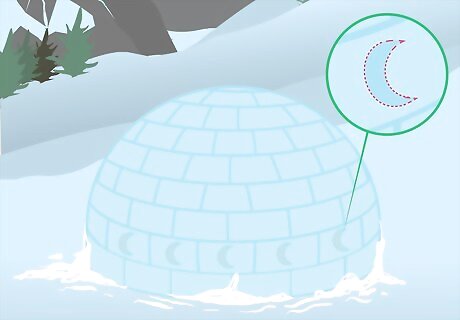
Carve vents in your igloo to prevent CO2 poisoning. Your body heat will cause the snow of your dome to melt and then freeze again, creating a barrier between the inside and outside of your igloo. Without ventilation this seal will prevent the CO2 that you exhale from escaping, and could seriously harm you. Cut small, crescent shaped vents into the top or sides of your igloo to prevent the buildup of CO2.

Cut your entrance. Now that you have the dome of your igloo created and some vents carved into place, you're ready to make an entrance. Use your snow knife/machete to cut a rectangle from the bottom of your block deep igloo base to about eye-level high, while crouching, in your dome wall. Your cut should be as deep as your dome wall is thick. Try to preserve this block by pulling it inside the igloo. You can save this block to create an overhang for your entrance.
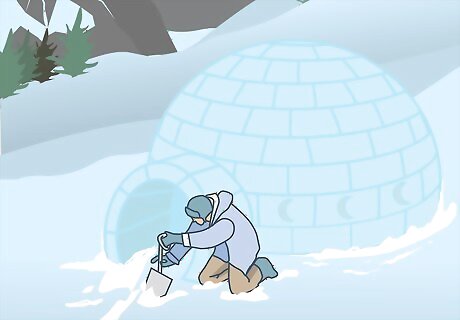
Clear your entrance way. Remove the remaining snow from your entrance in an gentle upward slope. You can pull this snow inside your igloo and use it for further patching gaps from the inside, or you can simply push it outside. Once your sloped entrance is finished, take the rectangular block you cut free of your dome wall and turn it on its side to remove it from your igloo. Then: Cut the rectangular dome-wall block in half. Lean each half of your block inward over your entrance trench so that each one holds the other up in an upside down V shape. This upside V overhang for your entrance should be as close to the mouth of the entrance as possible, to provide the most protection.
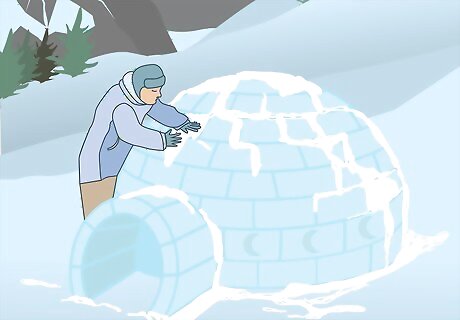
Strengthen your exterior with snow and enjoy your igloo. Your igloo can be made even more durable to patching thin spots and gaps with more snow. Some gaps may be most easily patched from the inside, while you might have better access to others from outside. In either case, use your hand to press the snow into the gap and then smooth the area to pack it together. You should be able to assess the stability of your igloo by touch. If the blocks feel solid and sturdy, your igloo should withstand the elements. Even if your igloo is a little on the rickety side, in the event of a cave-in, you'll be able to dig yourself free from the snow easily.


















Comments
0 comment